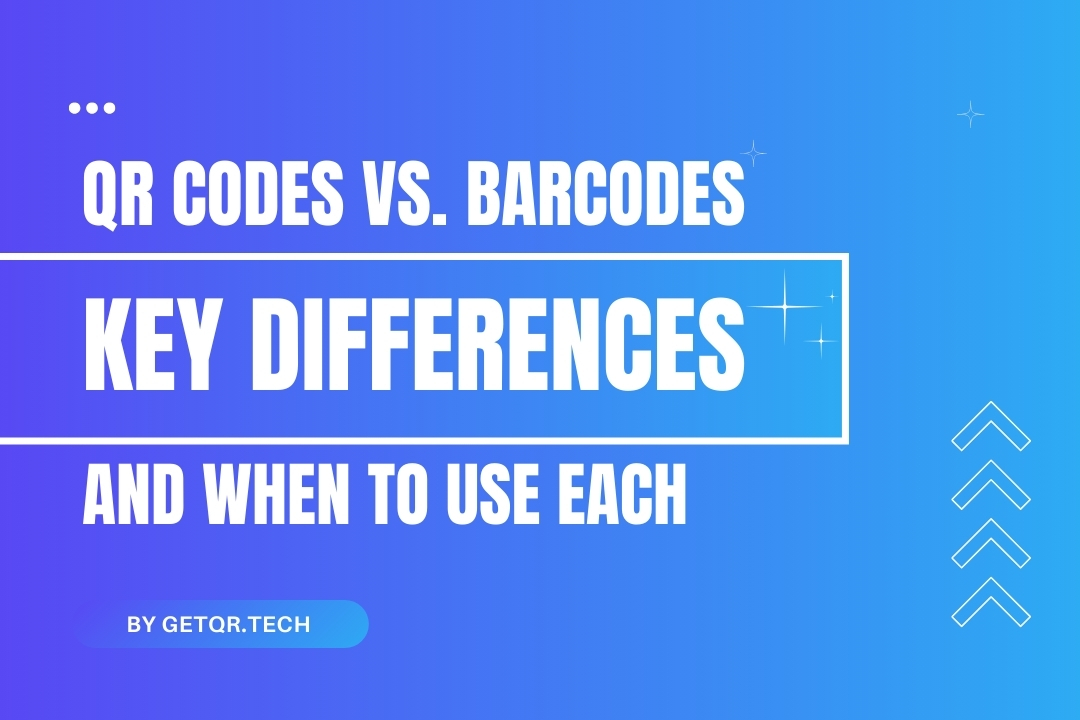
QR Codes vs. Barcodes: Key Differences and When to Use Each
Created on 9 April, 2025 • 264 views • 3 minutes read
Confused between QR codes and barcodes? Learn the key differences, best use cases, and when to use each. Generate both for free on GetQR.tech—no watermark!
QR codes and barcodes are both powerful tools used to store and share information quickly, but they serve different purposes and work best in different situations. If you're wondering which one to use—or when to use both—you’re in the right place.
In this beginner-friendly guide, we’ll walk you through the key differences between QR codes and barcodes, their pros and cons, and how to decide which one suits your needs best. Let’s get started.
What Is a QR Code?
A QR code (Quick Response code) is a type of 2D matrix barcode that can store a large amount of information in both vertical and horizontal directions. You’ve probably seen them on restaurant menus, business cards, posters, or product packaging.
At GetQR.tech, QR codes are our specialty. You can generate static or dynamic QR codes to share links, contact info, Wi-Fi credentials, text, and much more—no account required!
What Is a Barcode?
A barcode is a 1D (one-dimensional) code made up of vertical black lines and white spaces that store data in a linear format. You’ll most often find barcodes on retail products, library books, or inventory systems.
GetQR also supports over 34 barcode types, including Code 128, UPC, EAN, ITF, and more—perfect for businesses and logistics.
Key Differences Between QR Codes and Barcodes
| FeatureQR CodesBarcodes | ||
| Data Capacity | Up to 7,000+ characters | 8–25 characters (limited) |
| Design | Square, 2D | Linear, 1D |
| Scan Direction | 360° (multi-directional) | Horizontal only |
| Content Types | URLs, text, images, contact info | Numbers, product info |
| Customization | Colors, logos, styles | Minimal customization |
| Scanning Tools | Smartphone camera or app | Barcode scanner or app |
| Use Case | Marketing, mobile links, contactless menus | Retail, inventory, logistics |
When to Use a QR Code
QR codes are perfect when you need to:
- Share a URL or app download link
- Offer a digital business card
- Connect users to Wi-Fi
- Collect form responses
- Promote events with trackable links
- Use analytics & retargeting (dynamic QR codes)
💡 Pro Tip: With a free account on GetQR, you unlock unlimited QR code types, analytics, UTM tracking, and branding removal.
When to Use a Barcode
Barcodes are ideal for:
- Product labeling and scanning in retail stores
- Asset tracking for inventory management
- Library systems, warehouses, logistics, and shipping
- Items requiring numeric-only identifiers
They’re fast to scan, don’t require internet access, and are compatible with most POS systems.
Why Not Use Both?
You don’t have to choose one or the other. Many businesses use both barcodes and QR codes:
- Use barcodes for internal product handling (SKU, UPC)
- Use QR codes on packaging to provide manuals, videos, or marketing offers
GetQR lets you generate both QR codes and barcodes with a single account—unlimited, free, no watermark.
Final Thoughts
If you're running a small business, selling products, or launching a marketing campaign, knowing the difference between QR codes and barcodes helps you pick the right tool for the job.
Use QR codes when you want to connect, share, or engage with your audience. Use barcodes when you need efficient item tracking and scanning.
And with GetQR.tech, you don’t have to choose. Try both for free and see what works best for you!
✅ FAQs: QR Codes vs. Barcodes
1. Can QR codes store more information than barcodes?
Yes, QR codes can store thousands of characters, while barcodes are limited to about 25 characters.
2. Are QR codes better for marketing?
Absolutely. QR codes are great for linking to websites, videos, and app downloads—perfect for marketing and engagement.
3. Can I generate barcodes with GetQR?
Yes! With a free account, you can generate 34 different barcode types—no limits.
4. Do barcodes require special scanners?
Most barcodes need a laser or image scanner, but many smartphone apps can read them too.
5. Which is more secure: QR codes or barcodes?
QR codes can be password protected and tracked with analytics when using dynamic options—making them more versatile for secure content sharing.
Popular posts
-
-
How to Track QR Code Scans Using GetQR Analytics• 4,141 views
-
Top QR Code Use Cases in Education (With Free Tools)• 3,336 views
-
How to Create a QR Code for a PDF (Free & Easy)• 902 views
-